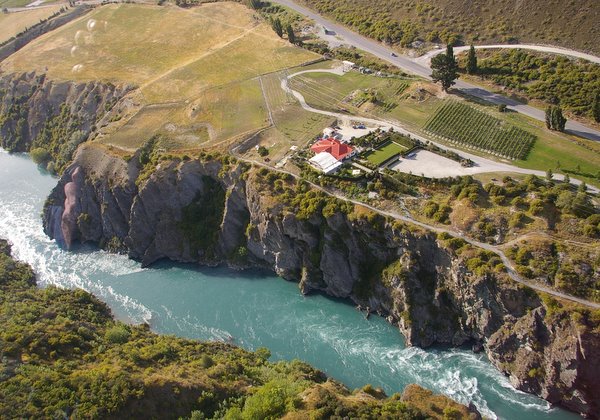As I write I am flying from Queenstown to Christchurch after less than a full day spent in Central Otago, one of the most visually striking wine regions on the globe. While the impressions are still fresh in my mind I wanted to try to capture some of them.
It is remarkable country. The quality of the light is one of the things that strikes me most. Because of the purity of the air, everything seems almost unreal: the colours are so vivid, and there’s no haze, so the hills and mountain tops stand all the more imposing.
The colours! We have the browns and ochres of the hills: it is dry here. In fact, this is one of the reasons this area was essentially uninhabited for so long. It would have been impossible to farm. Then we have the amazing vivid pale blues of the rivers, and the darker blues of the lakes. Yes, the water is actually blue here. Add in to the mix the green of the vineyards and farms. Because of the mountains, there is no shortage of water for irrigation.
In some ways this reminds me of Chile’s Elqui valley. It’s almost desert, the light is so pure, the scenery is so rugged.
So how do the wines reflect this wild sense of place?
This brings in the notion of terroir. On one level, terroir can be seen as a local flavour. That is, there’s a character unique or distinctive about the wines made here. On another level, can we relate the flavours in the wine to the place? Is there some quality that is expressed in the wine that brings to mind or captures the distinctiveness of Central Otago?
This is predominantly a Pinot Noir region. That’s what it is famous for. There aren’t many regions in the world where just one red grape variety is grown. The Northern Rhone is just Syrah. Burgundy is just Pinot Noir. I can’t think of any others. For Central Otago, there’s a tiny, tiny bit of Syrah, and there are probably experimental plantings of other varieties (this is the New World, after all), but it is just Pinot Noir. No other red variety will ripen reliably here.
Central Pinots do have a distinctive character. I don’t know how much success I’d have picking them blind from a line-up of New Zealand Pinots, but I reckon there probably are locals who can do this with a degree of success. In one sense, at least, it seems that there is a distinctive Central Otago terroir that overrides style differences in Pinot Noir winemaking. However, it must be noted that heavy handed winemaking or strange picking decisions could overwhelm terroir characters, and some vintages have a stronger vintage imprint result in less terroir transparency than others.
[The forthcoming Pinot Noir 2013 symposium will have a regional focus, and so it will be interesting in this context – with a concentrated bout of tasting of lots of wines – to see if I can really get a handle on regional variations in Kiwi Pinot Noir.]
But what of the second notion of terroir? When I drink a glass of decent Central Otago Pinot Noir, does it transport me back to the place. Can I taste – in some semi-synaesthetic way – the rugged, dramatic scenery of the region in the glass?
In a sense, yes, in as much that I have built up an association between the wines and the place they come from. A glass of Pinot speaks ‘Central Otago’ to me only because I have learned to associate the wine with the place. There is nothing fundamental in the sensory properties of the liquid in my glass that transmits an image of where it came from. To outsiders, such association might seem a bit fanciful. To me there is a richness in it, and it is one of the reasons I love wine.
In this way, a manufactured alcoholic beverage such as beer could have a similar sense of place. For this to occur, there would have to be a distinctive and local flavour shared among a number of beers from a place, that someone could then learn to associate with that place. With wine, the common, local taste is imparted by the physical characteristics of the vineyard, transmitted through the grape variety (and also the local yeast populations?), and interpreted by sensitive winemaking. Lacking this imprint of place that is dependent on local environmental conditions and entrenched cultural practices, it is much harder for beer to possess terroir in the same sense that wine has it. But it is not impossible.
2 Comments on Some thoughts on Central Otago and the sense of place in wine
Central Otago – what a beautiful place and a fantastic wine region. I still have 2 or 3 bottles left from Gibbston Valley Vineyards 2002 when I was last there, including a Merlot!
Vineyard restaurants in NZ also sublime, especially Twelve Trees in Blenheim, Marlborough. Now I want to go back!
Surely the major factor that mitigates against beer having “sense of place” is where the hops are grown? Here in the SW most are from Slovenia, with some from the US. After all, the water’s going to be neutral, everything else is manufactured.